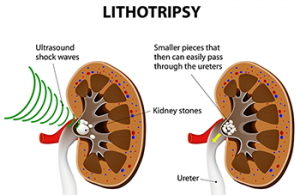Stone Management
What is Extracorporeal Lithotripsy?
 Extracorporeal shock wave lithotripsy is a nonsurgical treatment for kidney stones. It uses high-energy shock waves to break the stones into tiny pieces. The pieces can then be passed with urine.
Extracorporeal shock wave lithotripsy is a nonsurgical treatment for kidney stones. It uses high-energy shock waves to break the stones into tiny pieces. The pieces can then be passed with urine.
Lithotripsy is used to remove kidney stones that:
- Are too large to pass
- Cause constant pain
- Block the flow of urine
- Cause an ongoing infection
- Damage kidney tissue
- Cause bleeding
Most people who have lithotripsy for kidney stones are free of stones within 3 months of treatment. Those with stones in the kidney and upper ureter have the most success with treatment. There may be fragments that are too large to pass after the procedure. They can be treated with lithotripsy again.
Laser Stone Management
A stone lodged in your ureter and/or you kidney may need laser beaming to break it down, usually with general or regional anesthesia,this will happen thorough a special, very thin instrument used to look directly at and visualize the inside of the ureter and up to the kidney without a surgical incision – passing through the urinary opening- and with the help of a tiny flexible fiber that carries a laser beam to break the stone into smaller pieces that can then pass out of the body in your urine. How and what the doctor will do is determined by the location, size, and also the composition of the stone. The doctor may leave a stent (Double J Stent), a flexible tube that keeps the ureter open for drainage after the procedure for around one week.
Prior to Procedure
Dr. Haddad will do the following:
- Physical exam
- Blood and urine tests
- Imaging studies to help locate the stones
- You may be asked to stop taking some medications up to 1 week before the procedure.
Anesthesia
Sedation will keep you calm through the procedure.
Description of the Procedure
You will be placed on a soft cushion on top of a table. Shock waves can be passed to the stones through this cushion.
X-rays or ultrasound will be used to locate the stone. Your body will be positioned to target the stone. Shock waves will be passed through the stones until they are crushed. They will be crushed into pieces as small as grains of sand.
How Long Will It Take?
45-60 minutes
How Much Will It Hurt?
Anesthesia prevents pain during the procedure. There may be some pain and discomfort afterward from the passage of broken stones. There may also be some bruising on the area treated. Pain and discomfort after the procedure can be managed with medication.
Postoperative Care
You will be able to move almost immediately after the procedure. Drink plenty of water in the weeks after the procedure to help the stone pieces pass.


